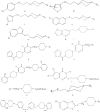Classification of 5-HT(1A) receptor ligands on the basis of their binding affinities by using PSO-Adaboost-SVM
- PMID: 20111683
- PMCID: PMC2812826
- DOI: 10.3390/ijms10083316
Classification of 5-HT(1A) receptor ligands on the basis of their binding affinities by using PSO-Adaboost-SVM
Abstract
In the present work, the support vector machine (SVM) and Adaboost-SVM have been used to develop a classification model as a potential screening mechanism for a novel series of 5-HT(1A) selective ligands. Each compound is represented by calculated structural descriptors that encode topological features. The particle swarm optimization (PSO) and the stepwise multiple linear regression (Stepwise-MLR) methods have been used to search descriptor space and select the descriptors which are responsible for the inhibitory activity of these compounds. The model containing seven descriptors found by Adaboost-SVM, has showed better predictive capability than the other models. The total accuracy in prediction for the training and test set is 100.0% and 95.0% for PSO-Adaboost-SVM, 99.1% and 92.5% for PSO-SVM, 99.1% and 82.5% for Stepwise-MLR-Adaboost-SVM, 99.1% and 77.5% for Stepwise-MLR-SVM, respectively. The results indicate that Adaboost-SVM can be used as a useful modeling tool for QSAR studies.
Keywords: 5-HT1A selective ligands; Adaboost-SVM; classification; particle swarm optimization; topological descriptor.
Figures
Similar articles
-
Classification of 5-HT(1A) receptor agonists and antagonists using GA-SVM method.Acta Pharmacol Sin. 2011 Nov;32(11):1424-30. doi: 10.1038/aps.2011.112. Epub 2011 Oct 3. Acta Pharmacol Sin. 2011. PMID: 21963891 Free PMC article.
-
Adaptive variable-weighted support vector machine as optimized by particle swarm optimization algorithm with application of QSAR studies.Talanta. 2011 Mar 15;84(1):13-8. doi: 10.1016/j.talanta.2010.11.039. Epub 2010 Nov 26. Talanta. 2011. PMID: 21315891
-
Particle swarm optimization and genetic algorithm as feature selection techniques for the QSAR modeling of imidazo[1,5-a]pyrido[3,2-e]pyrazines, inhibitors of phosphodiesterase 10A.Chem Biol Drug Des. 2013 Dec;82(6):685-96. doi: 10.1111/cbdd.12196. Epub 2013 Sep 19. Chem Biol Drug Des. 2013. PMID: 23906083
-
Prediction of Anti-proliferation Effect of [1,2,3]Triazolo[4,5-d]pyrimidine Derivatives by Random Forest and Mix-Kernel Function SVM with PSO.Chem Pharm Bull (Tokyo). 2022 Oct 1;70(10):684-693. doi: 10.1248/cpb.c22-00376. Epub 2022 Aug 2. Chem Pharm Bull (Tokyo). 2022. PMID: 35922903
-
Computational methods in determination of pharmacophore models of 5-HT(1A), 5-HT(2A) and 5-HT(7) receptors.Mini Rev Med Chem. 2013 Jun;13(7):933-51. doi: 10.2174/1389557511313070001. Mini Rev Med Chem. 2013. PMID: 23544602 Review.
Cited by
-
Curated Database and Preliminary AutoML QSAR Model for 5-HT1A Receptor.Pharmaceutics. 2021 Oct 16;13(10):1711. doi: 10.3390/pharmaceutics13101711. Pharmaceutics. 2021. PMID: 34684004 Free PMC article.
References
-
- Siracusa MA, Salerno L, Modica MN, Pittalá V, Romeo G, Amato ME, Nowak M, Bojarski AJ, Mereghetti I, Cagnotto A, Mennini T. Synthesis of new arylpiperazinylalkylthiobenzimidazole, benzothiazole, or benzoxazole derivatives as potent and selective 5-HT1A serotonin receptor ligands. J. Med. Chem. 2008;51:4529–4538. - PubMed
-
- Uphouse L. Multiple serotonin receptors: Too many, not enough, or just the right number? Neurosci. Biobehav. Rev. 1997;21:679–698. - PubMed
-
- Abbas SY, Nogueira MI, Azmitia EC. Antagonist-induced increase in 5-HT1A-receptor expression in adult rat hippocampus and cortex. Synapse. 2007;61:531–539. - PubMed
-
- Ögren SO, Eriksson TM, Elvander-Tottie E, D’Addario C, Ekström JC, Svenningsson P, Meister B, Kehr J, Stiedl O. The role of 5-HT1A receptors in learning and memory. Behav. Brain Res. 2008;195:54–77. - PubMed
-
- Millan MJ, Gobert A, Roux S, Porsolt R, Meneses A, Carli M. The serotonin1A receptor partial agonist S15535 [4-(benzodioxan-5-yl)1-(indan-2-yl)piperazine] enhances cholinergic transmission and cognitive function in rodents: a combined neurochemical and behavioral analysis. J. Pharmacol. Exp. Ther. 2004;311:190–203. - PubMed
MeSH terms
Substances
LinkOut - more resources
Full Text Sources


